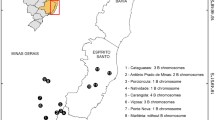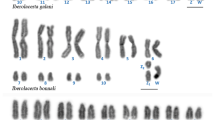Abstract
In Chortoicetes terminifera 45 independently-occurring B-chromosomes were tested and 23 distinct banding variants were detected with either G- or C-banding; six types were found more than once. In particular the Type I banding morph was detected 12 times indicating that individuals carrying this type may be under a different regime of selection compared with individuals bearing other types of banding morph; or the Type I may be subjected to a higher rate of meiotic drive in either or both sexes than other types. Also the Type I appeared to be obviously related to four other banding morphs whereas most types were not obviously related to any other banding morphs, but a few were similar in banding pattern to one or two other types. Three types of B-chromosomes were found in three or more different populations. A relatively high frequency of the Type I banding morph was found in one population, which was probably mainly composed of non-migratory individuals, and also in a laboratory-raised population. The most likely mechanisms for small changes in the banding sequence of the B-chromosomes are three-break insertions which are often indistinguishable from inversions. Rearrangements which add or delete bands, or sequences of bands, to or from B-chromosomes are probably the result of exchanges which are now known to take place in rare individuals with two B-chromosomes. The most distal region of all the banding morphs of the B-chromosome in C. terminifera, plus a short interstitial region in some types, is not late-replicating and has the banding characteristics of euchromatin. The rest of the chromatin of the B-chromosomes is heterochromatic and is the latest replicating heterochromatin in the whole genome. It consists of G-bands, which are also deeply stained with C-banding, and alternating G-interbands, which in turn are stained “grey” with C-banding. Both of these staining combinations are seen in heterochromatin of the normal complement. The heterochromatin of the B-chromosomes is condensed throughout 1st meiotic prophase in the male and in all somatic interphase nuclei where it can be quickly detected using the G-banding technique. The B-chromosome has a relatively constant, acrocentric morphology with a tendency to increase of length of the long arm as band numbers increase. Isochromosomes of the long arm have been seen only in laboratoryraised embryos. From egg pods with significantly fewer than expected B-chromosomes it is strongly suggested that more than one male may fertilize the eggs in a single pod.
Similar content being viewed by others
References
Greilhuber, J.: Why plant chromosomes do not show G-bands. Theor. Appl. Genetic. 50, 121–124 (1977)
Hewitt, G.M.: Meiotic drive for B-chromosomes in the primary oocytes of Myrmeleotettix maculatus. Chromosoma (Berl.) 56, 381–391 (1976)
Hunter-Jones, P.: Fertilization of eggs of the Desert Locust by spermatazoa from successive copulations. Nature (Lond.) 185, 336 (1960)
John, B., Hewitt, G.M.: The B-chromosome system of Myrmeleotettix maculatus (Thunb.) I. The Mechanics. Chromosoma (Berl.) 16, 548–578 (1965)
Lima-de-Faria, A.: The evolution of the structural pattern in a rye B-chromosome. Evolution (Lawrence, Kans.) 17, 289–295 (1963)
Luciani, J.M., Morazzani, M.-R., Stahl, A.: Identification of pachytene bivalents in human male meiosis using G-banding technique. Chromosoma (Berl.) 52, 275–282 (1975)
Nur, U.: Maintenance of a “parasitic” B chromosome in the grasshopper Melanoplus femur-rubrum. Genetics 87, 499–512 (1977)
Okada, T.A., Comings, D.E.: Mechanisms of chromosome banding. III. Similarity between G-bands of mitotic chromosomes and chromomeres of meiotic chromosomes. Chromosoma (Berl.) 48, 65–71 (1974)
Peters, G.: Germ line polysomy in Atractomorpha similis. Ph.D. Thesis, Australian National University 1977
Robinson, P.M., Hewitt, G.M.: Annual cycles in the incidence of B-chromosomes in the grasshopper Myrmeleotettix maculatus. Heredity 36, 399–412 (1976)
Sumner, A.T.: Banding as a level of chromosome organization. In: Current chromosome research (K. Jones and P.E. Brandham, eds.). Amsterdam: Elsevier/North Holland 1976
Wardhaugh, K.G.: A study of some factors affecting egg development in Chortoicetes terminifera. Ph.D. Thesis, Australian National University 1973
Webb, G.C.: Chromosome organization in the Australian plague locust, Chortoicetes terminifera. I. Banding relationships of the normal and supernumerary chromosomes. Chromosoma (Berl.) 55, 229–246 (1976)
Webb, G.C., Komarowski, L.: Haplo-diploid embryos arising by accidental thelytoky in Chortoicetes terminifera investigated by G-banding. Chromosoma (Berl.) 55, 247–251 (1976)
Webb, G.C., Westerman, M.: G- and C-banding in the Australian grasshopper Phaulacridium vittatum. Heredity (in press, 1978)
Webb, G.C., White, M.J.D.: Heterochromatin and timing of DNA replication in morabine grasshoppers. In: The eukaryote chromosome (W.J. Peacock and R.D. Brock, eds.), pp. 395–408. Canberra: Australian National University Press 1975
Webb, G.C., White, M.J.D., Contreras, N., Cheney, J.: Cytogenetics of the parthenogenetic-grasshoppers Warramaba (formerly Moraba) virgo and its bisexual relatives. IV. Chromosome banding studies. Chromosoma (Berl.) 67, 309–339 (1978)
White, M.J.D.: A cytological survey of wild populations of Trimerotropis and Circotettix (Orthoptera, Acridae). II. Racial differentiation in T. sparsa. Genetics 36, 31–53 (1951)
White, M.J.D.: Animal cytology and evolution, 3rd edit. Cambridge: Cambridge University Press 1973
Wurster-Hill, D.H., Gray, C.W.: The interrelationships of chromosome banding patterns in procyanids, viverrids and felids. Cytogenet. Cell Genet. 15, 306–331 (1975)
Yunis, J.J.: High resolution of human chromosomes. Science 191, 1268–1270 (1976)
Author information
Authors and Affiliations
Rights and permissions
About this article
Cite this article
Webb, G.C., Neuhaus, P. Chromosome organisation in the Australian plague locust Chortoicetes terminifera . Chromosoma 70, 205–238 (1979). https://doi.org/10.1007/BF00288407
Received:
Accepted:
Issue Date:
DOI: https://doi.org/10.1007/BF00288407




